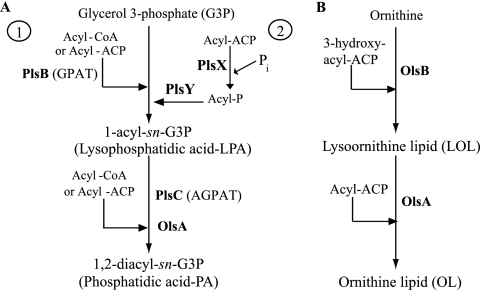FIG. 1.
PA and OL biosynthesis pathway in bacteria. (A) The first step for PA biosynthesis from G3P can be carried out by two different routes. In some bacteria, like E. coli, GPAT (PlsB) acylates the sn-1 position of G3P using either acyl-ACP or acyl-CoA to form LPA (step 1). In other bacteria, a recently identified route uses the soluble PlsX to convert acyl-ACP to acyl-phosphate (acyl-P), followed by the membrane-associated PlsY transferring the acyl chain to G3P (step 2). In all bacteria, the second step for PA biosynthesis is catalyzed by the membrane-associated AGPAT (PlsC) enzyme, which transfers an acyl chain from either acyl-ACP or acyl-CoA to LPA to yield PA. In R. capsulatus OlsA is alternative AGPAT enzyme for production of PA. (B) During OL biosynthesis, the first enzyme OlsB catalyzes the formation of an amide linkage (N-acyltransferase) between the α-amino group of ornithine and the carboxyl group of a 3-hydoxy fatty acid, forming LOL. The second enzyme, OlsA, catalyzes the formation of an ester linkage (O-acyltransferase) between the 3-hydroxy group of the fatty acyl group and the carboxyl of a second fatty acid, converting LOL to OL.

